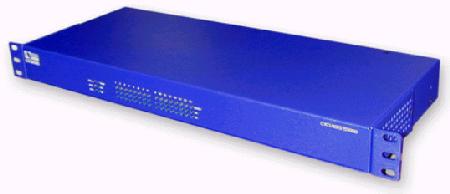Terminal/console access server taps hardened Linux
Nov 17, 2000 — by LinuxDevices Staff — from the LinuxDevices Archive — 1 viewsCyclades has announced a new terminal and console access server in a 1U rackmount form-factor that uses MontaVista Software's Hard Hat Linux as its embedded operating system. The TS2000 can be used by ISPs, ASPs, and e-retailers to manage, remotely and securely, serial console ports in server farms. With the increasing demand for processing capacity, the use of server farms and clustering is on the rise and the Linux-based TS2000 is designed to offer a robust and secure management solution. The TS2000 can also be used as a PPP server to provide access to dialup clients or telecommuters using analog modems, based on its relatively high port density — 32 console ports — in just 1U of rack space.

We asked Marcio Saito, Director of Technology at Cyclades, to comment on why his company decided to switch to Linux from its internally developed proprietary “CyROS” Internetworking operating system. We also wondered why they settled on Hard Hat Linux. Here's what we learned . . .
Why Linux?
“Networking boxes typically use proprietary Internetworking OSes — Cisco IOS, Cyclades CyROS, etc. Those OSes are optimized for networking and are very space-efficient. Great. But they are proprietary. Of course, that means the users must learn a new OS, and cannot modify/extend/customize the functionality of the box beyond what was previously determined by the vendor. A new generation of network appliances using open architectures (hardware and/or software) promises to completely change the Networking market. That market, by the way represents a couple of hundred billion dollars a year — roughly an order of magnitude larger than the general purpose server/desktop OS market.”
“By leveraging on standard hardware components and open source software, new vendors will be able to:
- Offer products with more functionality at a lower cost
- Be viable without the high volumes required by proprietary designs
- Eventully dominate the new Networking market
“Our TS2000 is an example of how the use of Open Source software can produce a product that is functionally equivalent to a typical proprietary terminal server (e.g. Cyclades-PR3000, Lucent Portmaster 2, Cisco 2511) but also offers the option for the user to extend/customize/modify its functionality. And because we spent a lot less effort in software, the product is more affordable.”
Why Hard Hat?
“First, it's important to realize that our project is truly “embedded” in nature, since it's based on proprietary hardware (not a standard motherboard), doesn't contain a hard disk (boots from Flash), and uses a Motorola MPC860 (not a standard server/desktop 'X86' CPU).”
“We had been debating the use of Linux to replace our proprietary and home-built CyROS Internetworking OS for at least 2 years, but the challenge of embedding Linux on a proprietary platform kept us from taking that step. Even as a company that embraced Linux and the Open Source concept (Cyclades was, after all, the first hardware company in the world to commercially develop and support Linux products in 1993), it was a difficult decision to discard software that has over 100 programmer-years of engineering in it in the context of our networking boxes.”
“MontaVista offered specific support for the MPC860, technologies to handle Flash/RAMdisk operation, and professional services to support our project. Thus, with Hard Hat Linux and the backing of MontaVista, we finally had the confidence to take on the project of porting our system to Linux. The results: we had Linux up and running on our hardware within just two weeks of starting the project, and within five months will have deployed first units at customer sites.”
This article was originally published on LinuxDevices.com and has been donated to the open source community by QuinStreet Inc. Please visit LinuxToday.com for up-to-date news and articles about Linux and open source.